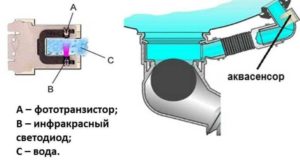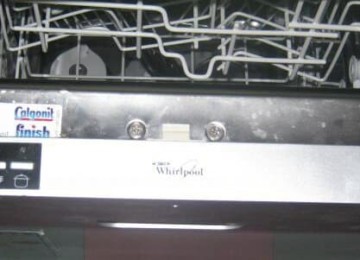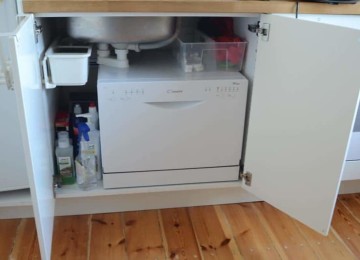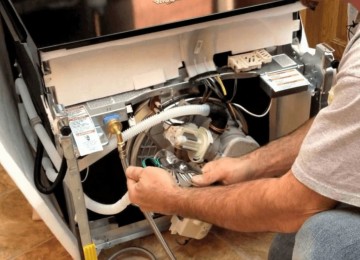 Modern dishwashing units are equipped not only with standard program modes, but also with additional options. These also include washing plates in automatic mode, performed thanks to the aquasensor present in the dishwasher. Many users do not know what it is, and today we propose to understand how the aqua sensor works in a dishwasher.
Modern dishwashing units are equipped not only with standard program modes, but also with additional options. These also include washing plates in automatic mode, performed thanks to the aquasensor present in the dishwasher. Many users do not know what it is, and today we propose to understand how the aqua sensor works in a dishwasher.
What is an aquasensor?
This literally translates to “water sensor”. The name is relative, so the manufacturer suggests calling it an aquasensor for turbidity or water purity. Its main purpose is to perform water survey on the degree of turbidity in the washing chamber, identify how much food waste remains in the liquid, whether there is dishwashing detergent, etc.
Why is this necessary? The process is explained simply - a signal is sent from the aquasensor to the electronic board, the modular device sets certain program actions - it activates the drain when the water is clean enough, or continues washing the dishes, since the liquid is still cloudy.
Aquasensor device
Sensor for monitoring water turbidity dishwashing equipment represented by an infrared LED and a phototransistor. The elements are located on one board, one opposite the other. The board is housed in a dense case that does not allow light to pass through, its shape resembling the letter “U”. The diode directs an infrared ray that passes through the water poured into the machine and hits the photoresistor.
If there is no cloudiness in the water, the dishwasher reapplies it, eliminating the additional rinse. If the turbidity level is elevated, the receiver is unable to recognize the beam signal and the machine changes the water to cleaner water.
At the end of the next rinse, the information from the aquasensor is calibrated, and the unit determines the degree of purity of the solution. This option helps to save at least 4 liters of water per cycle, without compromising the quality of work.

Which dishwashers have a water purity sensor?
The technology that determines water turbidity was first implemented in dishwashers from manufacturers Bosch and Siemens. These sensors are not installed on inexpensive models, and they are available in mid-level and elite class units.
Let's name a few examples:
- Bosch SPV 53MOO – narrow body model, completely built-in under the sink or in a cabinet;
- Bosch SMV 50E10 – another built-in full size dishwasher;
- Siemens SR 66T090 – narrow model for washing plates;
- Bosch SPV 63M50 – a narrow machine equipped with additional functions.
Somewhat later, the water turbidity sensor began to be installed in more expensive machine models from other manufacturers of household appliances.But its name was slightly different from that invented by Bosch specialists.
For example, the manufacturers of the Miele model range gave this sensor the name “Eco-sensor”, and the Hotpoint-Ariston company called it Sensor System.
In any case, the water turbidity control sensor in dishwashing equipment – an example of new technologies that allow you to control the quality of washing plates. The sensor helps:
- regulate the number of plate rinsing processes, thereby saving water;
- reduces work cycle time;
- reduces electrical energy consumption.
Changing the turbidity sensor yourself
A device that controls the purity of the water in the chamber is located at the bottom of the dishwasher. The aquasensor is inserted into the pump connector and can be replaced without any problems.
The algorithm of actions is as follows:
- remove the body panel of the machine;
- We find the turbidity sensor and remove it from the mounting socket. To do this, the wiring is detached, the clamps are pressed out, and the failed sensor is removed;
- a new aquasensor is being prepared. The seal removed from the old sensor is put on, lubricated on the outside with a liquid composition for washing plates or gel;
- pressing a little on the turbidity sensor, install it in place, connect the wires;
- assembly of dishwashing equipment is carried out in the reverse order;
- the machine is connected to all communications;
- Dishwashing equipment is tested in a test mode with a small number of dishes to make sure that everything works correctly.
Conclusion
So, we figured out what functions the turbidity sensor performs. If the aqua sensor fails, you can always replace it with a new analogue without involving service center specialists.









